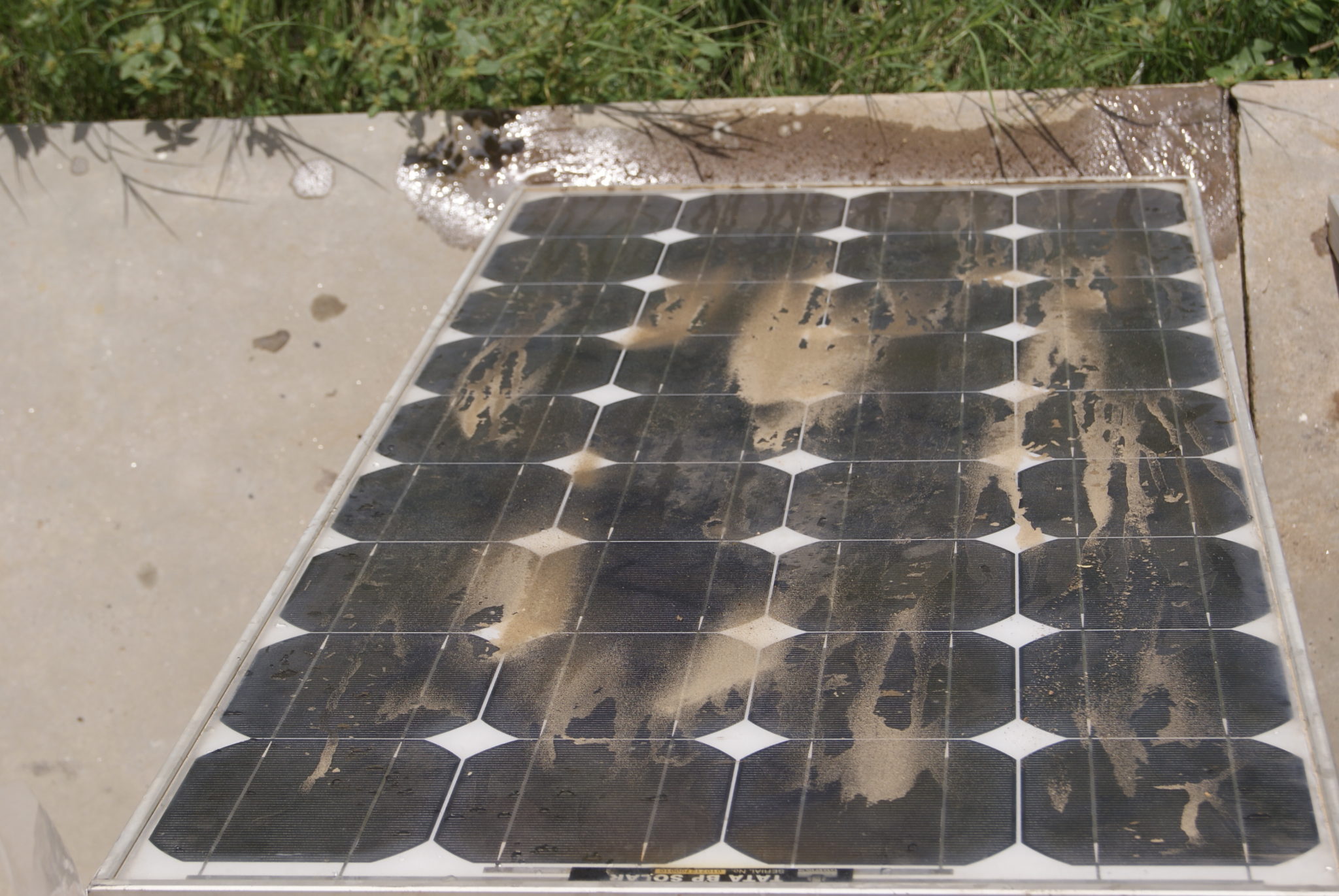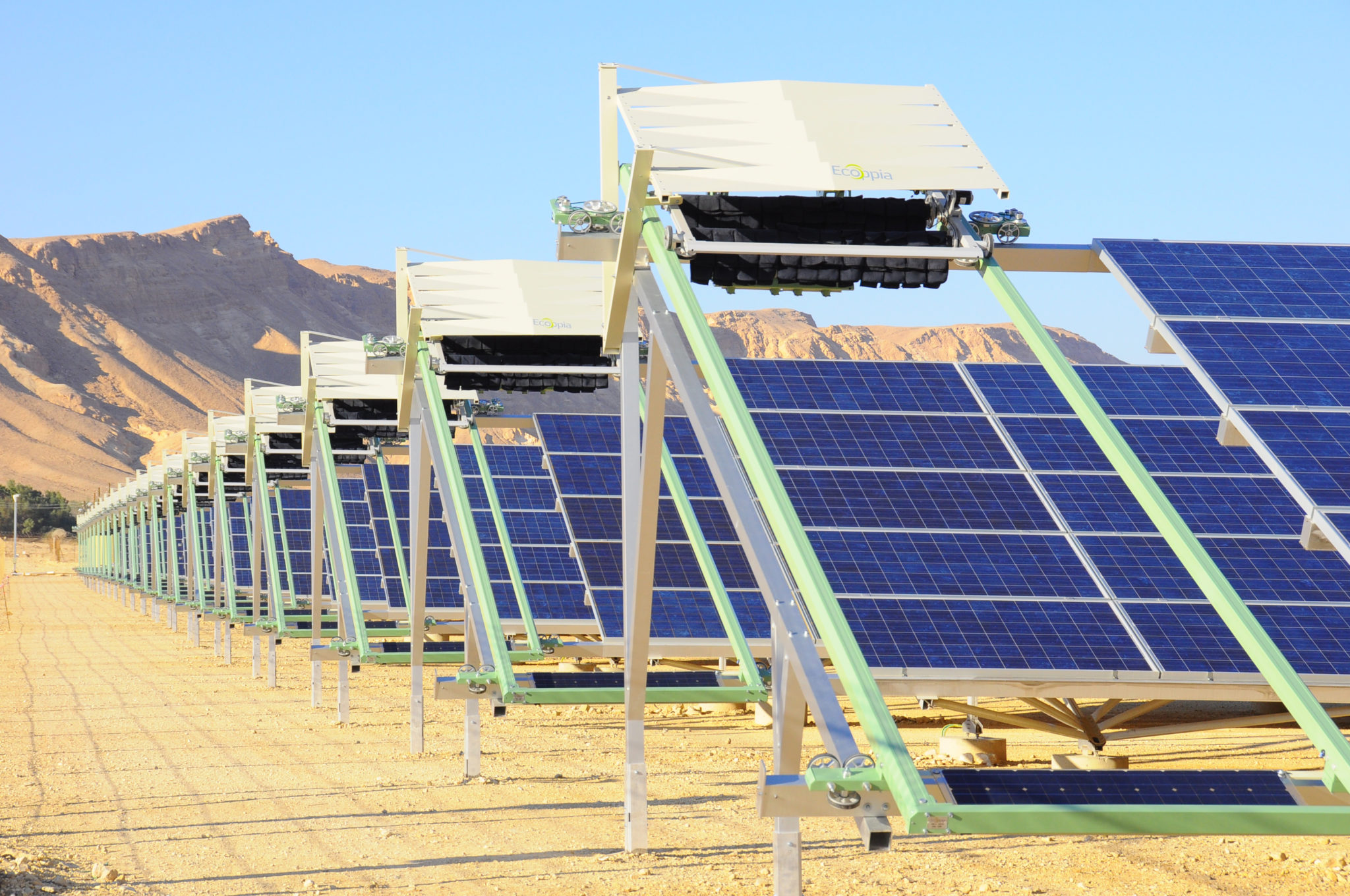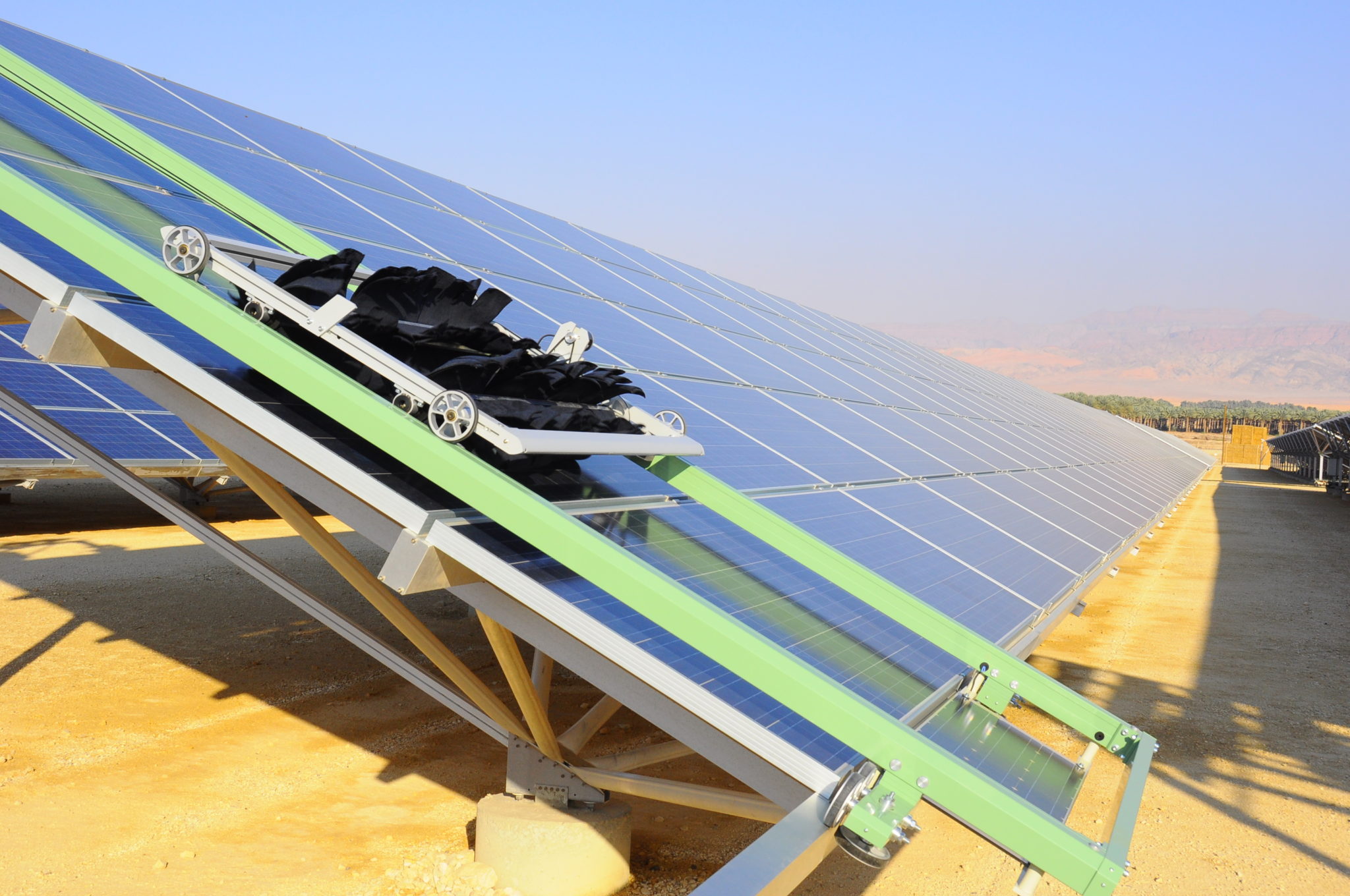Muscovite, dolomite, calcite, palygorskite and quartz: while the words may not be all that familiar, they are the compound names of some of the most commonly found elements on earth, namely – dust particles. Everybody can relate to the dry, scratchy feeling of having a dusty throat, or examining the detritus on the back of one’s hand after wiping their brow on a hot, dry day. Dust, soil and soot gets everywhere, in the right conditions. And it is a rather ironic offshoot of the solar industry’s expansion that optimal dusty conditions are often aligned perfectly with optimal solar conditions.
Soiled solar modules are, have always been, and will always be, a cause of concern for PV plant owners. Transmission losses caused by dirty panels can vary greatly, however, dependent upon the exact weather conditions, localized terrain, tilt angle, and even the types of panels installed. Awareness of the impact of soiling on a plant owner’s internal rate of return (IRR) is growing in lockstep with increasingly scientific and innovative methods to not only deal with the impact of soiled modules via more effective cleaning, but also improved anti-soiling coatings and more considerate installation practices.

What can the module do?
At the most lo-fi level, dealing with soiled and dusty solar modules is easy: grab a bucket filled with water, take a cloth and clean them by hand. In many parts of the world such a practice is still commonplace – a jarringly labor-intensive and low-tech maintenance process for installations comprising incredibly sophisticated PV components.
Solar power is gaining massive prominence in many of the world’s poorest and developing countries. While labor costs are low in places such as India, Africa and Southeast Asia, cleaning crews still represent a sizable financial outlay – particularly as many of the solar parks in these emerging regions are very large and usually quite remote. The Netherlands’ DSM – a producer of backsheets and anti-reflective coating for solar modules – last year introduced a new, high performance anti-soiling coating that it claims can not only help modules outperform standard anti-reflective coating modules by approximately 1.3%, but can also yield a number of indirect maintenance savings such as a reduced number of cleaning cycles and thus less use of labor and consumables.
“Module glass treated with the DSM anti-soiling coating soils less quickly and is easier to clean, while maintaining its anti-reflective properties,” Jan Grimberg, DSM’s business director told pv magazine. “By reducing the soiling rate, modules can maintain their optimal performance for longer.”
DSM’s anti-soiling coating, which can be applied onsite at the glass producer’s facilities, is proven to boost the IRR of solar projects. The coating was tested at a TÜV SÜD site in Dunhuang, China, after three years of development and both indoor and outdoor validation tests. In an example calculation of the coating’s impact, DSM says that a 10 MW solar farm located in a desert-like environment and subjected to a soiling rate of 0.5% per day (that is, 0.5% of the module surface will accrue dust on a daily basis) can assume an effective 50% reduction in the soiling rate when the modules use the anti-soiling coating. The Dutch firm calculates that, based on average cleaning costs of $500/MW, and an assumed electricity price of $0.08/kWh, the plant owner can enjoy an EBITDA profit increase of 3.8% due to higher electricity output of 1.7% and lower cleaning costs of around -30%.
“The coating is based on our proprietary core-shell particle technology and optimized to minimize soil dust adhesion, and maximize dust removal,” said Grimberg. “It is an inorganic coating and thus has better UV resistance than coating containing organic or fluorine components, which will typically degrade faster under high UV loads found in desert-like environments.”
The coating was introduced in April 2017 and have already been installed in plants ranging between 5 to 10 MW in size. DSM says that larger projects above 50 MW in scale are also in progress. “This is a growing area of interest for both project developers and other downstream players, particularly in emerging markets,” Grimberg confirmed. “Our role is to create more awareness for solutions that are now on the market. Dirt is a science. That is why we are collecting so much data from many different sites, to offer examples of the difference that good anti-soiling coating can make in terms of IRR.”
Know your terrain
Grimberg was keen to stress that anti-soiling coatings are not a “one-size fits all” solution: the exact circumstances of a solar installation can also determine just how impactful soiling can be. In the vast landscapes of India, which are increasingly dotted with not just large-scale solar parks but other tangible markers of industrial and economic growth such as factories and textile plants, the conversation about how best to mitigate the impact of solar module soiling is gathering pace.
“The magnitude of soiling concern varies from region to region and customer specifics,” said Pravar Joshi, director of Indian solar developer Insolergy. “For example, a solar plant in Chandrapur is near to a thermal power plant. This leads to fly ash deposits on the modules, which therefore require more frequent cleaning. We also know of one solar park located next to a mill that processes pulses, thereby pumping a continuous stream of fine particles into the air. Thus, the rate of deposits on the panels is much higher than average.”

Image: Ecoppia
While Joshi agrees that awareness of soiling impacts is growing, he has seen cases where solar farms had suffered a 50% fall in performance due to non-cleaning of modules, often for several months. “We offer annual maintenance contracts to our customers with bi-weekly or monthly cleaning options, but frequency should really be decided on a site-by-site basis.”
Subrahmanyan Pulipaka, CEO of Soreva, told pv magazine that soiling is seldom a concern among EPCs when building large-scale plants in India. “It has always been a post-factor consideration. The trend currently in India is to be reactive rather than proactive on soiling.”
As part of Pulipaka’s work at India’s National Institute of Solar Energy (NISE), he has modelled and examined a series of scientific data – in India and also the U.S., Jordan, Iraq, Morocco and the UAE – that looks specifically at how soiling can best be mitigated at the planning stage. “If we take appropriate measures while designing the solar plant, such as module tilt angles and make them soiling-compatible, then the post-installation O&M can be minimized.”
Popular content
Soreva studies at plants located in Rajasthan have compared optimum tilt angle for a clean panel against optimum tilt angle for a panel that will be most impacted by soiling. In many cases, it is simply a matter of altering the angle by one or two degrees to mitigate the worst effects of dust and soot. “By doing this, an EPC can help create resistance towards soiling on the panel,” said Pulipaka. “Hence, the impact of soiling can be minimized if soiling parameters are considered while deciding the module tilt, instead of just inclining it with the value equal to the latitude.”
Additional weather pattern examinations – such as wind strength at certain locations and time of the year – can also yield insightful data that can help to mitigate the worst impacts of soiling. A proponent of this analytical approach is Kipp & Zonen, a specialist in solar radiation measurements that has developed a Dust IQ Optimal Soiling Measurement (OSM) that measures sun reflection every minute and can translate that information into real time soiling loss data. The tool weighs around 4kg and can be linked across a string of modules during the measurement process.

Cleaning innovation
Despite the increasingly sophisticated methods available to mitigate the effect of soiling on solar modules, dust cannot be kept at bay entirely – and especially not in hot desert regions. Another irony of building solar farms in such locations is often a lack of water for cleaning, or rather, an acute understanding that in water scarce regions, solar farms should not be too much of a drain on resources.
The growth in low-water and water-free module cleaning devices reflects this reality. Leading players in this space include the U.S. firm Alion Energy, which offers both wet and dry cleaning solutions with its automated SPOT cleaning robot.
Israel’s Ecoppia has enjoyed rapid global expansion over the past few years, buoyed largely by the growing popularity of its E4 cleaning system, which can remove 99% of soiling from solar panels without using a drop of water. Ecoppia’s solution instead employs special microfibers that wipe the soil away, aided by a controlled airflow over the module surface that helps to dislodge the particles. Gravity does the rest.
The firm recently raised $13 million in a third financing round to further widen its global footprint. Ecoppia CEO and co-founder Eran Meller told pv magazine that the firm’s goal is to use this financing to deliver new products to market in 2018 that will further automize the solar module cleaning pace. “We are looking at lots more data analytics in order to improve the cleaning service we offer,” Meller said. “Robotics and machine learning are here to stay, and to ensure the scalability of our technology, financial backing is very important.”
Meller believes that not only are more and more EPCs beginning to look at the longer term opex of their solar plants, but banking and financial institutions that back these large-scale PV developments are insisting that solar developers are properly hedging their risks long-term.
“EPCs are now actively considering the price of water over the next 25 years, as well as the cost of labor. By adopting a water-free, automated solution such as Ecoppia’s E4, developers are basically mitigating all of those risks, meaning the opportunity for returns on investment are higher,” said Meller.
Ecoppia’s cleaning solutions have been deployed across hundreds of megawatts of solar across the world, and it is the quantifiable data available on the company’s cloud-based platform that is enabling other investors to see how effective such automated cleaning solutions are. “This becomes a self-fulfilling prophecy because the more that investors and EPCs fully understand how clean modules increase IRR, the more they are willing to invest, which aids our own economies of scale.”
Soiled modules are also prone to overheating. Where dust has accumulated, hotpots can occur, which accelerates the likelihood of potential induced degradation (PID). In hotter regions, where the panels are subjected to higher levels of atmospheric heat, these problems can be further exacerbated – making it even more vital to maintain a dust-free solar plant.
This content is protected by copyright and may not be reused. If you want to cooperate with us and would like to reuse some of our content, please contact: editors@pv-magazine.com.


When we will manage to introduce an accurate modeling system for the effects of soiling, the industry will really understand the importance. NREL is doing some efforts but we have a long way to run…
I would like to add to the above the significant influence that glass construction and humidity can bring.
Although it is important, it is wrong to refer only to energy efficiency. Equally, it is the protection of the investment. The report of SolarBankability, the only work in the world, with reference to 452MWp operated PV plants (2.5Million modules), shows that 23.4% of PV module problems comes from soiling !!
What about the energy footprint? How much water every m2 of PV glass surface need for cleaning? How often?
What’s the CAPEX & OPEX for robotic cleaning systems?
Till we managed to handle cement in Cyprus Island, one of the most «difficult» deposits, I m optimistic….
With the surfacing of blockchain technologies, innovation looks not close to over, and new and innovative functions and technologies emerge. We attempt to orchestrate the adoption of an entirely decentralized ecosystem through distributed ledger technologies. It most certainly is an exceptionally exciting time to be established in the blockchain space and as lots of people take on this disruptive innovation, it is going to conceivably enable us to create a more reliable, fair and open world.